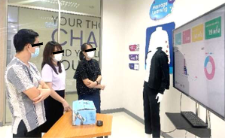A Smart Learning System with Sensors and Tracking System for Enhancing Learning Experience in Applied Thai Traditional Medicine Students
Main Article Content
บทคัดย่อ
A massage learning kit embedded sensors and a smart tracking system employed the Internet of Things (IoT) technology to develop and create modern innovative learning material by using force sensors to measure the force response for the study of Applied Thai Traditional Massage. The pressure level of the finger is significant for Thai massage as it needs gentle pressure to relax the whole body. Therefore, it is crucial for learners to practice the techniques of applying pressure using thumbs and fingers and adjust the degree of pressure. Consequently, the learning kit embedded sensors and a tracking system was developed to enhance learners’ motivation and engagement in learning for practicing Thai massage. Learners would actively study and practice from trial-and-error learning as the learning kit can show the degree of pressure which increase the understanding of the lesson and promote effective classroom participation in learning making real differences in students' skill when compared with the traditional classroom.
Article Details

อนุญาตภายใต้เงื่อนไข Creative Commons Attribution-NonCommercial-NoDerivatives 4.0 International License.
เอกสารอ้างอิง
Bodily, R., Ikahihifo, T. K., Mackley, B., & Graham, C. R. (2018). The design, development, and implementation of student-facing learning analytics dashboards. Journal of Computing in Higher Education, 30(3), 572–598. https://doi.org/10.1007/s12528-018-9186-0
Boonruab, J., Poonsuk, P., & Damjuti, W. (2020). Effect of Court-Type Thai Traditional Massage Versus Senokot Treatment on Chronic Constipation: A Randomized Controlled Trial. Journal of Evidence-Based Integrative Medicine, 25. https://doi.org/10.1177/2515690X20960644
Kawai, T., Son, D., & Miyahara, Y. (2019). What students learned from “Thai medicine seminar”: Implication for education in medical communication. Cogent Education, 6(1). https://doi.org/10.1080/2331186X.2019.1674588
Roberts, D. (2019). Higher education lectures: From passive to active learning via imagery? Active Learning in Higher Education, 20(1), 63–77. https://doi.org/10.1177/1469787417731198
Sayorwan, W., Phaekhunthot, S., Chumworathayee, P., & Udompittayason, J. (2017). Development of a 3D Para Rubber Model for Practicing Massage Skill of TTM Students of Kanchanabhisek Institute of Medical and Public Health Technology. Journal of Nursing and Education, 10(3), 71–82.
Schwendimann, B. A., Rodriguez-Triana, M. J., Vozniuk, A., Prieto, L. P., Boroujeni, M. S., Holzer, A., Gillet, D., & Dillenbourg, P. (2017). Perceiving learning at a glance: A systematic literature review of learning dashboard research. In IEEE Transactions on Learning Technologies (Vol. 10, Issue 1, pp. 30–41). Institute of Electrical and Electronics Engineers. https://doi.org/10.1109/TLT.2016.2599522
Si, W., Srivastava, G., Zhang, Y., & Jiang, L. (2019). Green internet of things application of a medical massage robot with system interruption. IEEE Access, 7, 127066–127077. https://doi.org/10.1109/ACCESS.2019.2939502
Sucharit, W., Eungpinichpong, W., Chatchawan, U., & Peungsuwan, P. (2019). The effects of Thai massage on leg muscle oxygenation and time to fatigue in healthy male subjects. International Journal of GEOMATE, 17(61), 14–20. https://doi.org/10.21660/2019.61.4527


